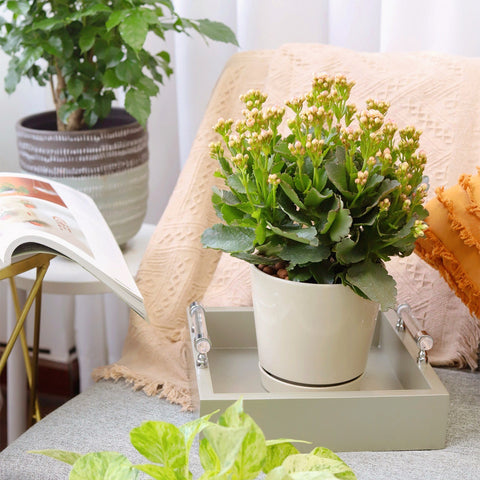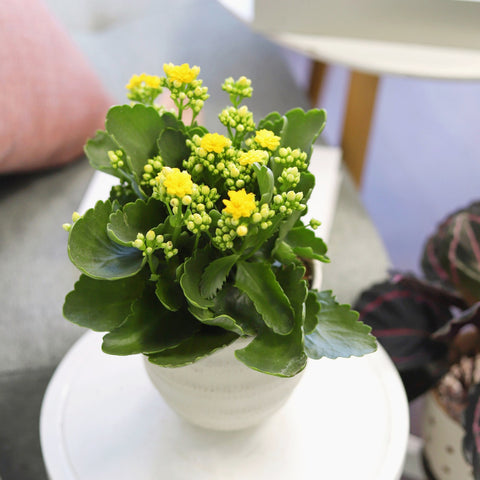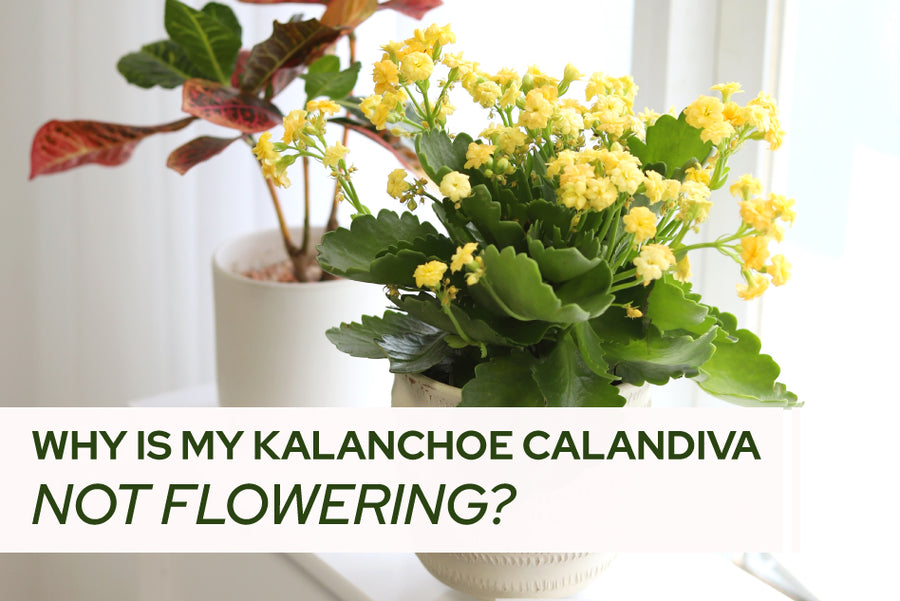Kalanchoe blossfeldiana Calandiva is one of the most popular flowering houseplants that you can find in all flowering shops and markets. This plant is a favorite gift plants for all occasion, and people love them for their glossy leaves and vibrant, long-lasting blooming. Whether it's a birthday, anniversary, or just a heartfelt gesture, Calandiva has become the top pick for those looking to give a lasting present.
Unlike traditional houseplants, Calandiva belongs to the resilient family of succulents. Native to Madagascar, this species is a member of the Crassulaceae family. What sets Calandiva apart is its stunning clusters of tubular, bell-shaped flowers that come in an array of colors, including shades of pink, red, orange, and white.
The popularity of Calandiva can be attributed to its ability to thrive both indoors and outdoors, making it a versatile choice for plant lovers with varying gardening preferences. Its compact size, coupled with the captivating display of blooms, makes it an excellent addition to windowsills, tabletops, and gardens alike. Beyond its aesthetic appeal, Calandiva is known for its low maintenance requirements, making it accessible to both seasoned gardeners and those new to the world of succulents.
However, growing a happy Calandiva comes with its share of challenges, and when those expected blooms don't show up, it's a big concern for plant parents. Beyond the cosmetic aspect, the absence of flowers could be a clue to some deeper issues impacting the overall health of this succulent. By understanding the factors that influence this plant’s blooming behavior, plant enthusiasts can provide the optimal care required for a flourishing Calandiva.
[Bloom Cycle]What Is Kalanchoe Blossfeldiana Calandiva Bloom Cycle?
Kalanchoe blossfeldiana Calandiva is loved for its remarkable tendency to bloom frequently and abundantly, making it a favored choice among plant enthusiasts. The frequency of its flowering is influenced by a range of factors, including environmental conditions like temperature, lighting, and watering. In its native habitat or when cultivated outdoors, this succulent usually experiences its main blooming cycle during the spring and early summer, showcasing vibrant bell-shaped flowers in a stunning display of colors. Calandivas have a bloom time of 6-8 weeks. This natural blooming pattern is often followed by a rest phase where the plant directs its energy towards foliage growth. However, with proper care and attention, Calandiva has the potential to bloom multiple times throughout the year, especially when grown indoors.

This succulent usually experiences its main blooming cycle during the spring and early summer.
The manipulation of light exposure to mimic natural photoperiods, coupled with regular feeding using a balanced fertilizer during the growing season, encourages the succulent to initiate new flower buds. The post-blooming period also plays a crucial role, with the removal of spent flowers promoting new growth and contributing to the overall health of the plant. By managing light exposure, ensuring proper care, and allowing for rest periods, we can encourage more frequent and vibrant flowering in their Calandiva succulents.
[Why Calandiva not blooming]Why Isn’t My Kalanchoe blossfeldiana Calandiva Blooming
There are various reasons for why your Calandiva not blooming, and here are the most crucial factors:
Dormancy
The occurrence of dormancy can significantly influence the flowering behavior of Kalanchoe blossfeldiana Calandiva. In its native habitat or when grown outdoors, Calandiva may naturally enter a period of dormancy, often occurring during late fall and winter. This is a time when the plant conserves energy, reduces growth, and may exhibit fewer flowers. Calandiva may produce fewer flowers, and the intensity of blooming may decrease during this period as the plant prioritizes energy conservation over reproductive efforts. It is important to realize your Calandiva’s dormancy period and not to encourage blooming during this time. As dormancy naturally subsides and the plant transitions to a more active growth phase, Calandiva is likely to resume its blooming cycle.
Immaturity
One reason why your Calandiva isn’t flowering may be that it is not mature enough. In the early stages of development, Calandiva focuses primarily on vegetative growth, channeling energy into establishing a robust root system and developing lush foliage. During this period, the plant may not allocate substantial resources to flower production. This succulent requires time to reach a sufficient level of maturity where it can shift its priorities from foliage growth to reproductive efforts, including the production of vibrant flower buds.
Generally, Calandiva starts blooming once it reaches a certain level of maturity, typically in its second year or as it attains a specific size. It's important to note that there can be variability among individual plants, and some may start blooming earlier or later than others. Environmental factors, such as light levels and temperature, can also influence the timing of flowering. Providing proper care, including well-draining soil, appropriate watering, and adequate light exposure, contributes to the overall health and development of Calandiva. If you have a young plant, give it time and consistent care to support its transition to maturity and the initiation of flowering.
Spent Flowers
The presence of old, spent blooms on a Kalanchoe plant can indeed impact its energy allocation and blooming potential. Old blooms represent parts of the plant that have completed their reproductive cycle. If these spent flowers are left on the plant, it continues to allocate energy to maintain them, diverting resources away from potential new growth and blooming. By removing or deadheading the old blooms-either by cutting or pinching them away-you prompt the plant to redirect its energy towards producing new buds. This process stimulates fresh growth and encourages the development of new flowers, promoting a continuous and vibrant blooming cycle. Regularly inspecting the Kalanchoe for old blooms and promptly removing them as part of a maintenance routine is essential.
Incorrect Watering
Proper watering is important for the health and blooming potential of Kalanchoe blossfeldiana Calandiva. The delicate balance between hydration and soil moisture plays a crucial role in supporting this succulent's transition to a reproductive phase and its ability to bloom. Proper hydration supports the succulent's growing processes, ensuring it has the energy and resources needed to produce flower buds.

Proper hydration supports the succulent's growing processes, ensuring it has the energy to produce flower buds.
On one hand, overwatering poses a significant threat to Calandiva, leading to the risk of root rot. Excess moisture in the soil creates a favorable environment for pathogens that can damage the roots, compromising the plant's ability to absorb nutrients, reducing blooming, and affecting overall health. On the other hand, insufficient watering deprives Calandiva of essential nutrients and moisture, limiting its ability to support robust growth and flower production. The succulent may enter a survival mode, prioritizing basic functions over blooming. Monitoring your plant’s signs of incorrect watering and adjusting your watering schedule may help to ensure successful blooming.
Inadequate Lighting and Temperature Conditions
The lighting and temperature conditions to which a Kalanchoe plant is exposed play a pivotal role in its blooming behavior. If these factors are not optimal, the plant may struggle to initiate or sustain its blooming cycle. Kalanchoe is a plant that requires adequate light to trigger and maintain its blooming cycle. Without sufficient light exposure, the plant may not receive the signals necessary to initiate the reproductive processes that lead to flower bud development.
In low-light conditions, Kalanchoe may experience reduced or inhibited flower bud formation. The plant's energy is directed more towards sustaining basic growth rather than allocating resources to reproductive efforts. Moreover, insufficient temperature variations, especially during the plant's natural flowering period, can stall the progression of reproductive processes. This can result in a lack of blooming or a delayed blooming cycle.
Lack of Resting and Low Light Period
For Kalanchoe plants to thrive and undergo successful blooming cycles, they require specific periods of rest and exposure to low light conditions. These natural rhythms are crucial for triggering the reproductive processes that lead to the development of flower buds. Kalanchoe typically benefits from a resting period, often induced by shorter day lengths and cooler temperatures. During this phase, the plant transitions from active growth to a more subdued state, preparing for the initiation of flower buds. Without a proper resting period, Kalanchoe may experience continuous growth without the necessary pause to reset its physiological processes. This can lead to a lack of bud initiation and blooming. Kalanchoe may struggle to form flower buds without the cues provided by low light conditions.

Pests and Diseases
Diseases and pest infestations impose stress on plants, disrupting their normal growth. This stress response can divert the plant's resources away from reproductive efforts, such as flower bud development. When plants face threats from diseases or pests, they often allocate energy and resources toward defense mechanisms. This may involve producing defensive compounds or activating other stress response pathways, leaving fewer resources available for growth and reproduction. Regularly inspect plants for signs of diseases or pests. Early detection allows for prompt intervention, minimizing the potential impact on flowering.
[Encourage Your Canlandiva To Bloom]How To Encourage Your Kalanchoe Calandiva To Bloom?
To encourage optimal blooming in your Kalanchoe, follow this specific care regimen about 6 weeks before the desired bloom time:
- Remove spent flowers: Promptly remove any spent flowers. This redirects the plant's energy towards ongoing growth and blooming.
- 14-Hour Dark Period: Provide the plant with a 14-hour period without light daily. Place the Kalanchoe in a dark space, such as a closet or under a box, during this period. This extended dark phase mimics the natural conditions that trigger the transition to the blooming phase.
- 10 Hours of Bright Light: After the 14-hour dark period, expose the plant to 10 hours of bright light daily. This combination of darkness and light signals the plant to prepare for blooming.
- Temperature: Keep the plant in a warm environment and away from drafts. Consistent and slightly elevated temperatures contribute to the successful transition to the blooming phase.
- Reduce Watering and Stop Feeding: As the plant enters a dormant state during these 6 weeks, further reduce watering and completely stop feeding. This dormant phase sets the stage for the plant to focus on internal processes that lead to the development of flower buds.
Once you observe the formation of buds, it indicates that your Calandiva is in transition to the blooming phase. As soon as flower buds are visible, relocate the plant to a brighter location. The increased light exposure supports the final stages of blooming and ensures vibrant and healthy flowers.
































































































